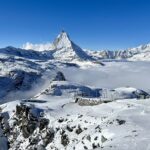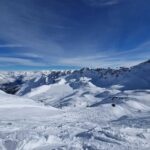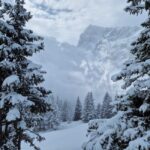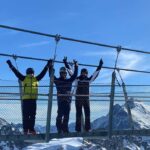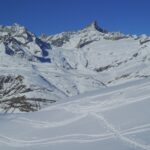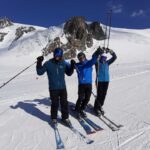When is The Best Time to Come Ski in Switzerland?
Ah, Switzerland. Land of chocolate, cheese, and some of the most breathtaking ski slopes on the planet. As seasoned ski professionals who are carved up more Swiss snow than we care to admit, we’re here to spill the beans on the best time to ski in Switzerland.
Whether you’re from the sunny shores of California or the bustling streets of New York, this guide will help you pinpoint the perfect time to pack your bags and hit the Swiss slopes.
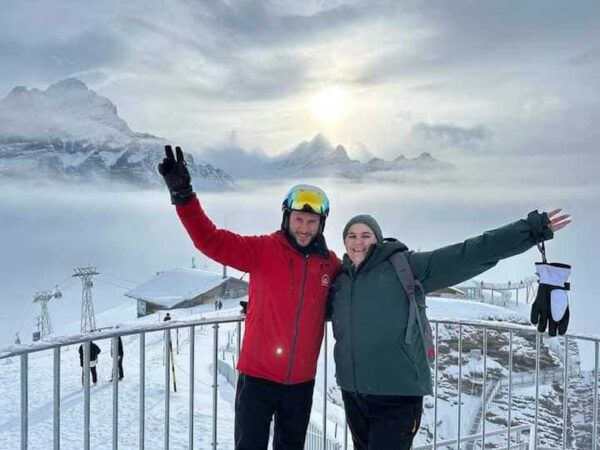
Christmas and New Year's Eve: The Festive Flurry
The holiday season in Switzerland is nothing short of magical. Picture this: snow-covered chalets, twinkling lights, and the sound of carolers in the air.
If you’re dreaming of a white Christmas, then December is your month. The festive spirit is contagious, and there’s something incredibly special about spending Christmas or New Year’s Eve in a Swiss ski resort.
By mid-December, most resorts have a solid base of snow, thanks to both natural snowfall and snowmaking efforts, so the conditions are typically excellent for skiing. Snowfall averages around 50-70 cm/20-30 inches in December, providing a great foundation for the season. The efficient snowmaking systems in Swiss resorts ensure that even if Mother Nature isn’t cooperating fully, there will still be plenty of snow to enjoy.
And if you’re looking for the best ski resorts for the festive season we highly recommend Zermatt and St. Moritz.
Zermatt boasts one of the highest ski areas in Europe, with lifts reaching up to 3,883 meters/12,739 feet at the Klein Matterhorn and offers over 360 kilometers/224 miles of pistes, catering to all levels from beginners to advanced skiers.
The wide range of runs ensures that everyone can find their perfect slope. St. Moritz is another high-altitude resort with ski areas reaching up to 3,303 meters/10,837 feet at the Piz Nair. With 350 kilometers/217 miles of pistes, St. Moritz offers a diverse range of runs, from gentle slopes for beginners to challenging black runs for experts. The well-groomed pistes and scenic views make it a top choice for skiers.
These resorts are renowned for their festive celebrations and top-notch pistes. Both resorts offer family-friendly amenities, including ski schools for the little ones and plenty of non-ski activities like ice skating, and festive markets. Plus, you’ll witness the most breathtaking vista of the Mattherhorn.
We can defiantly say that skiing in December will let you experience the magical atmosphere of your dreams, with festive activities and fresh snowfall that you won’t find anywhere in the world.
Just keep in mind that this will be the most crowded and high price season of all, but we promise, it will be 100% worth it. The key is to book early to secure the best accommodations and take advantage of early-bird deals. At My-Mountians, we offer all-inlcusive ski packages that will make it easier to plan your trip.

January: The Snow Hound's Paradise
For those who take their skiing seriously, January is arguably the best time to ski in Switzerland.
The holiday crowds have dispersed, and you’re left with quieter slopes and often the best snow conditions of the season. January is typically the coldest month, which means the snow is often at its driest and fluffiest. Fresh powder is a common sight, making it ideal for those deep powder turns.
Engelberg and Davos are top choices for January.
Engelberg, with its famous off-piste runs, is a haven for powder hounds. The Titlis glacier reaches an impressive height of 3,239 meters/10,627 feet and the snow in Engelberg is legendary.
The cold temperatures ensure that the it remains light and powdery, perfect for off-piste adventures. The resort averages around 100 cm/40 inches of snow, providing an excellent base for skiing. With over 82 kilometers/51 miles of pistes, Engelberg offers a variety of runs, but it’s the off-piste terrain that truly stands out.
Davos boasts a high elevation with its ski areas peaking at 2,844 meters/9,331 feet at the Weissfluhjoch. Known for its reliable snow, Davos receives around 89 cm/35 inches of snowfall in January.
The vast ski area and varied terrain ensure that there’s something for every skier, from powder fields to perfectly groomed runs. Davos offers an extensive 320 kilometers / 199 miles of pistes, spread across five mountains. The diversity of the terrain means you can find everything from beginner slopes to challenging black runs.
The cold temperatures in January mean you’ll need to bundle up. Looking like a Michelin Man is a small price to pay for those pristine powder days.
“Skiing is the next best thing to having wings.”
– Oprah Winfrey –
February: Final Chance for Peak Skiing
February is, without a doubt, one of the best times to hit the slopes in Switzerland.
By this time, the snow has had ample time to accumulate and settle, providing excellent skiing conditions. The Swiss Alps receive regular snowfall throughout the winter, ensuring a consistent and thick blanket of snow, which means you’re less likely to encounter those dreaded icy patches that can send even the most seasoned skier into an unintended interpretive dance down the mountain.
February strikes a perfect balance between the bone-chilling cold of January and the warmer, sometimes slushy days of March. Temperatures are generally more moderate, making for more comfortable skiing without the risk of frostbite every time you take off your gloves to snap a selfie.
While December and January are peak holiday seasons, February tends to be less crowded. This is particularly true outside of the school holiday periods, so you’ll spend less time in lift lines and more time carving up the pristine Swiss slopes.
Plus, fewer people mean a higher chance of snagging that perfect après-ski spot by the fire. As the days begin to lengthen, you’ll enjoy more daylight hours to spend on the slopes. This means you can ski longer and take in more of the stunning alpine scenery without feeling rushed to get back before dark.
February is also a vibrant time in Switzerland, with numerous winter festivals and events. From traditional Swiss carnivals like Fasnacht to international ski competitions, there’s always something exciting happening. It’s not just about skiing; it’s about experiencing the rich culture and festive spirit of Switzerland. And let’s be honest – all that skiing is just a prelude to indulging in Swiss chocolate, cheese fondue, and perhaps a bit of après-ski glühwein (mulled wine).
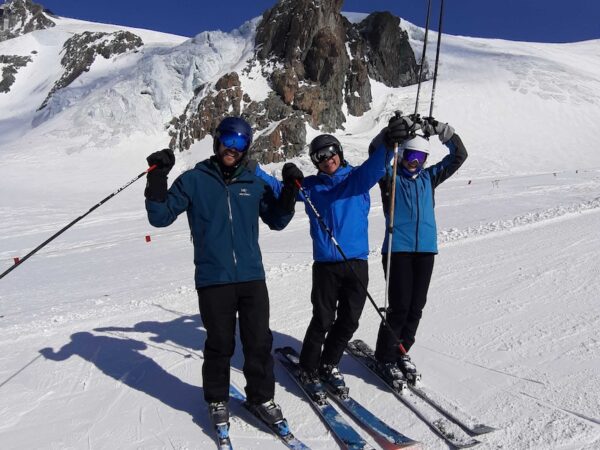
March: Spring Skiing Bliss
March is a fantastic time to ski in Switzerland, especially if you enjoy a bit of sunshine with your snow.
The days start to lengthen, temperatures are milder, and the après-ski scene becomes even more vibrant.
By March, higher altitude resorts still have excellent snow, ensuring great skiing conditions. While lower slopes can get a bit slushy by afternoon due to the milder temperatures, the higher elevations maintain fantastic snow quality. The combination of natural snowfall and effective snowmaking ensures that you’ll have plenty of good runs to choose from. Average snowfall in March is around 59-89 cm/25-35 inches, which keeps the pistes well-covered and enjoyable.
Verbier and Saas-Fee are prime choices for March skiing. Verbier’s extensive ski area, with over 410 kilometers / 255 miles of pistes, is one of the largest in Switzerland.
Verbier is also legendary for its après-ski scene. From lively bars to sophisticated lounges, there’s something for every taste. The energy in Verbier after a day on the slopes is infectious, with live music, dancing, and plenty of socializing.
Saas-Fee’s glacier skiing reaches up to 3,573 meters/11,722 feet. The glacier ensures that Saas-Fee has some of the most reliable snow conditions in Switzerland. Even in March, when lower resorts may struggle with slushy conditions, Saas-Fee’s higher slopes remain pristine. The resort offers 150 kilometers/93 miles of pistes, with a good mix of runs for all skill levels.
We should say that March is perfect for those who enjoy après-ski as much as skiing itself. The warmer temperatures and longer days make outdoor après-ski activities more enjoyable. From mountain-top bars to village pubs, the après-ski options are plentiful and diverse.

April: Last Chance For Great Slopes
April marks the tail end of the best time to ski in Switzerland, but don’t write it off just yet. The end-of-season vibe is something special, with sunny days and a festive atmosphere.
Higher altitude resorts still have good snow, ensuring you can enjoy your ski vacation even as the season winds down. Lower slopes might be closed, but what’s open is usually well-maintained and enjoyable.
In April, the snow at higher elevations stays in good condition due to cooler temperatures overnight and efficient grooming by resort staff. Average snowfall is around 50 cm/20 inches, but the sunny weather and longer days make for an enjoyable experience.
Zermatt and Verbier again come out on top for April skiing.
Both Zermatt and Verbier excel in providing family-friendly amenities. Ski schools in these resorts continue to offer lessons for children and beginners, ensuring that everyone in the family can enjoy their time on the slopes.
While higher altitude resorts like Zermatt and Verbier maintain good snow conditions, skiing in April does come with some variability. Lower altitude slopes may be closed or have patchy snow, so it’s essential to choose resorts with higher elevations. Morning skiing often offers the best conditions, with firmer snow that softens as the day warms up.
April brings longer, sunnier days, creating perfect conditions for enjoying the beautiful Swiss Alps. The festive end-of-season atmosphere includes events, parties, and special activities designed to celebrate the conclusion of another successful ski season. The lively après-ski scene, combined with warmer weather, makes it an ideal time for socializing and enjoying outdoor terraces.
One of the significant advantages of skiing in April is the availability of great deals. As the season winds down, many resorts offer discounted lift passes, accommodation, and package deals. This makes April a cost-effective time to enjoy a high-quality ski vacation without breaking the bank.
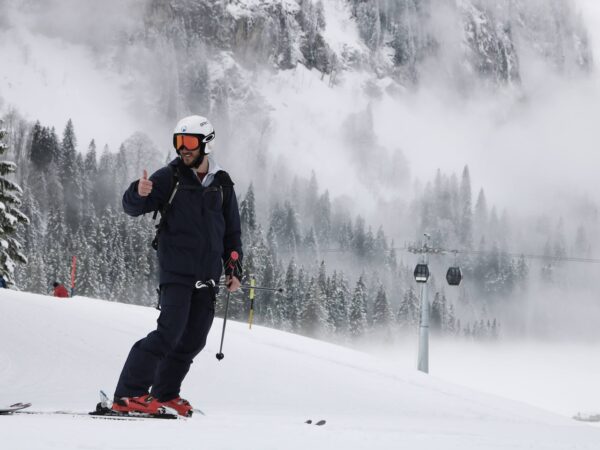
Final Tips for the Best Time to Ski in Switzerland
Here are some tips that will be uselful when choosinh the best time to ski in Switzerland.
- Book Early: Especially for peak times like Christmas and New Year’s Eve. The best accommodations and ski schools fill up fast.
- Check the Snow Reports: Conditions can vary, so keep an eye on the latest snow reports to ensure you’re hitting the slopes at their peak.
- Pack Smart: Layers are key. And don’t forget the sunscreen – those sunny spring days can be surprisingly intense.
The best time to ski in Switzerland largely depends on what kind of experience you’re after. Whether it’s the festive magic of December, the powder perfection of January, the sunny bliss of March, or the celebratory vibes of April, Switzerland has something to offer every ski enthusiast.
So, what are you waiting for? Start planning your Swiss ski adventure now, and make sure to visit our website for the best deals and insider tips. See you on the slopes!
Switzerland Ski Packages
Check out our latest Articles:
-
 Ski Trips in the Swiss Alps: Luxury, Thrills & Adventure Guaranteed26 February 2025/0 Comments
Ski Trips in the Swiss Alps: Luxury, Thrills & Adventure Guaranteed26 February 2025/0 Comments -

-
 Top 10 Swiss Ski Resorts for Winter Holidays10 January 2025/
Top 10 Swiss Ski Resorts for Winter Holidays10 January 2025/ -
 Discover the Magic of Wengen Ski Resort20 December 2024/
Discover the Magic of Wengen Ski Resort20 December 2024/ -
 Switzerland Ski Packages: Your Hassle-Free Vacation29 November 2024/
Switzerland Ski Packages: Your Hassle-Free Vacation29 November 2024/ -
 Zermatt Ski Resort: Discover All our Experts Insights12 November 2024/
Zermatt Ski Resort: Discover All our Experts Insights12 November 2024/ -



